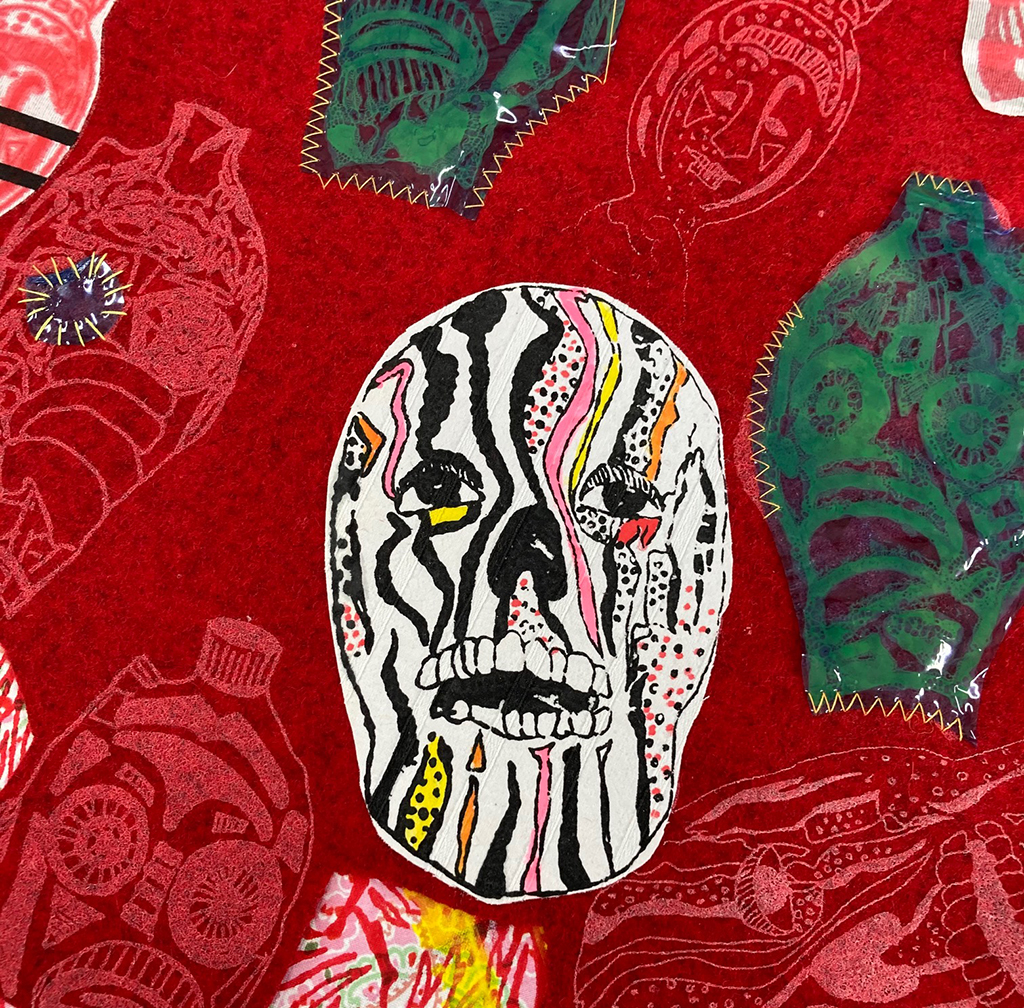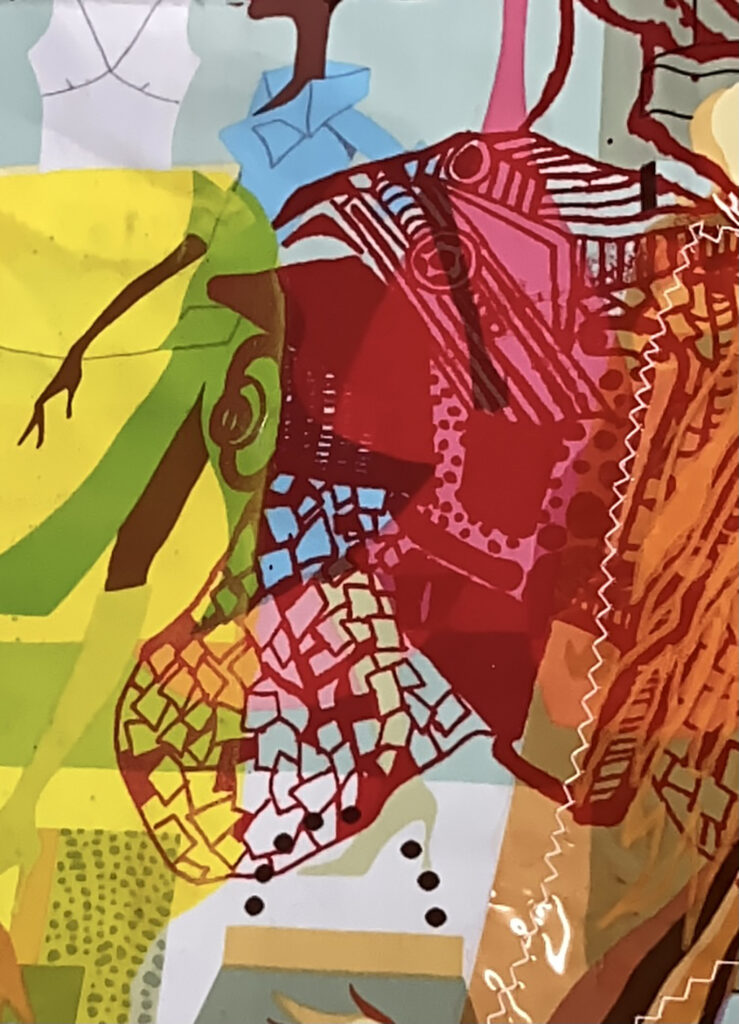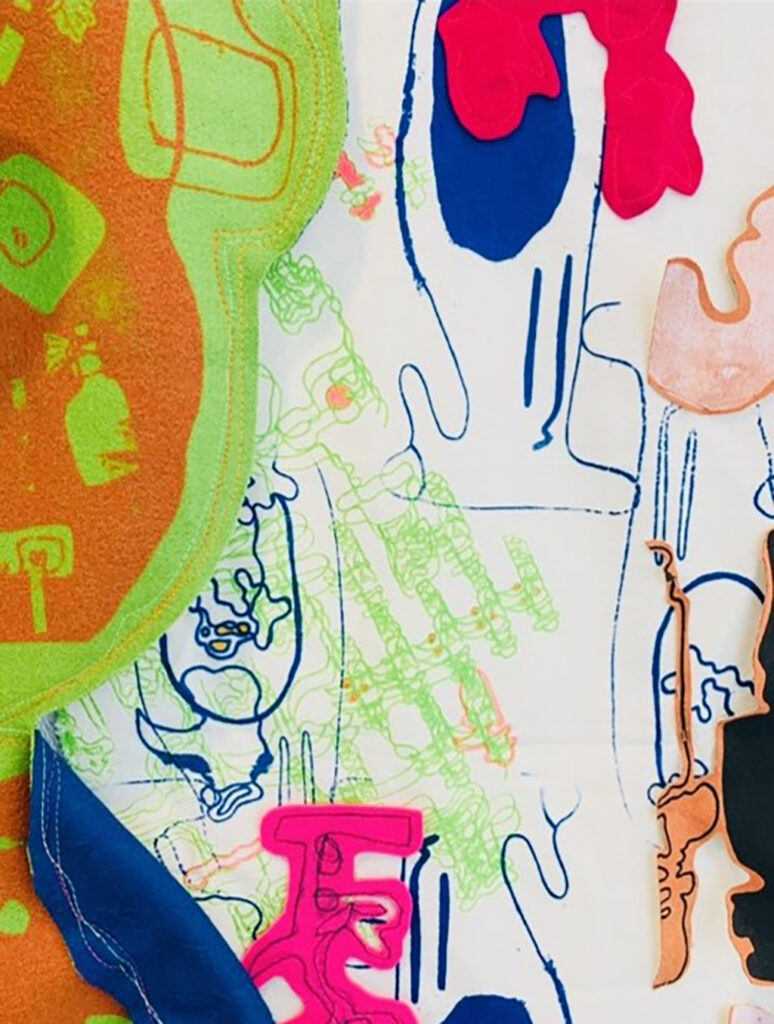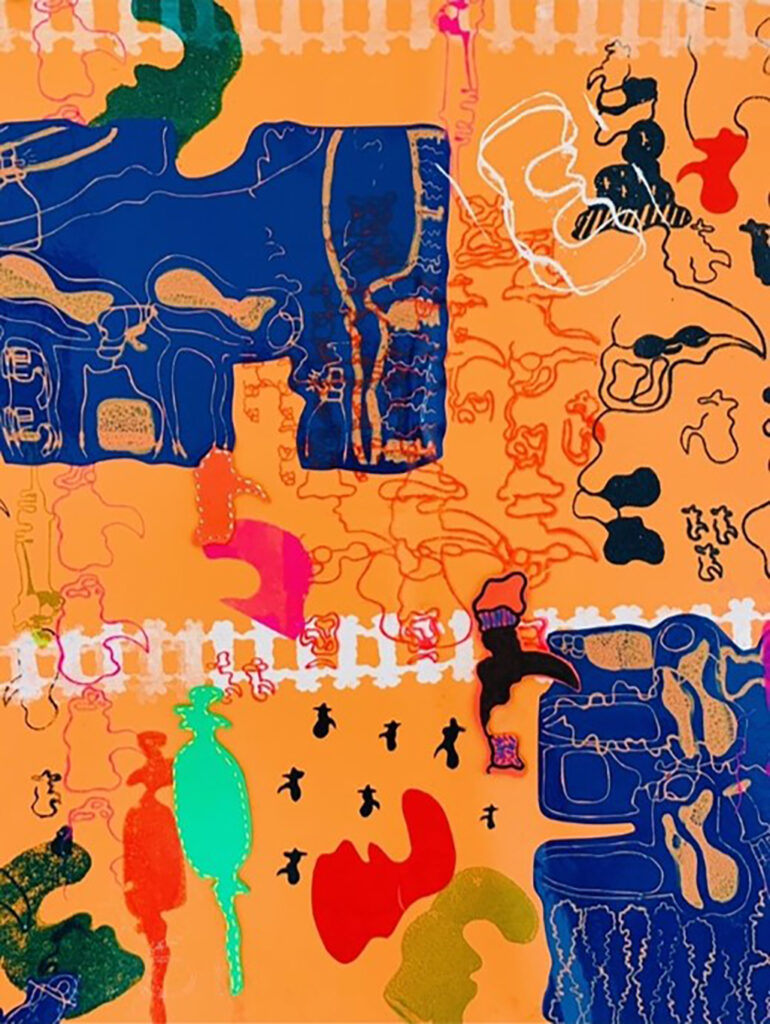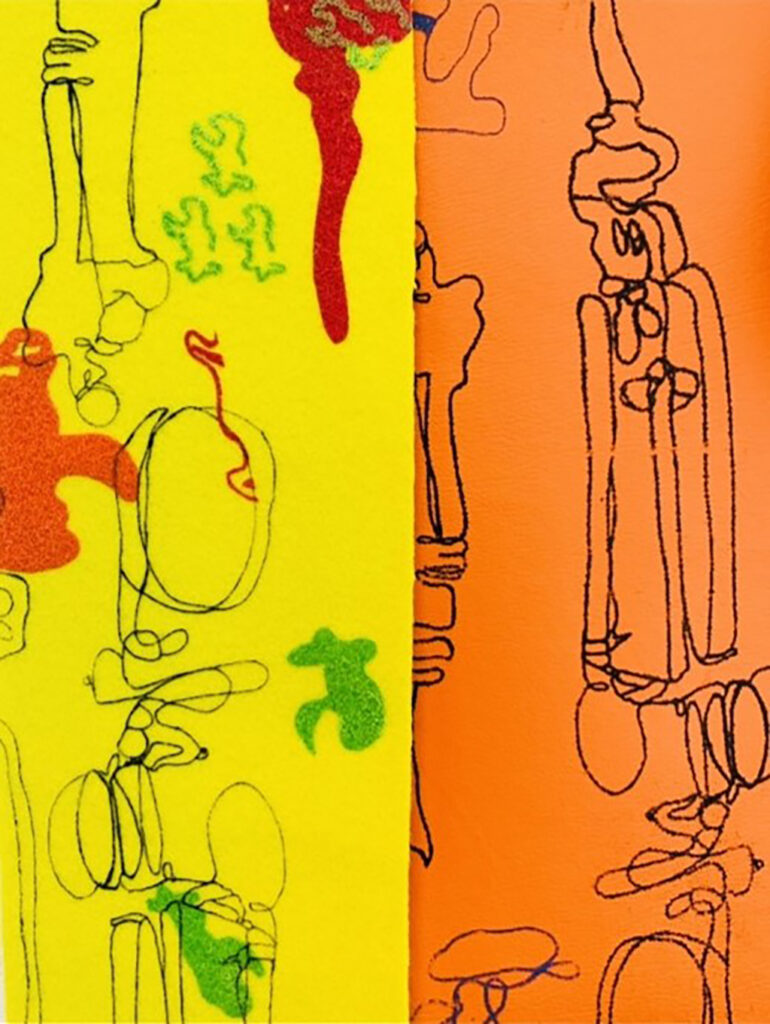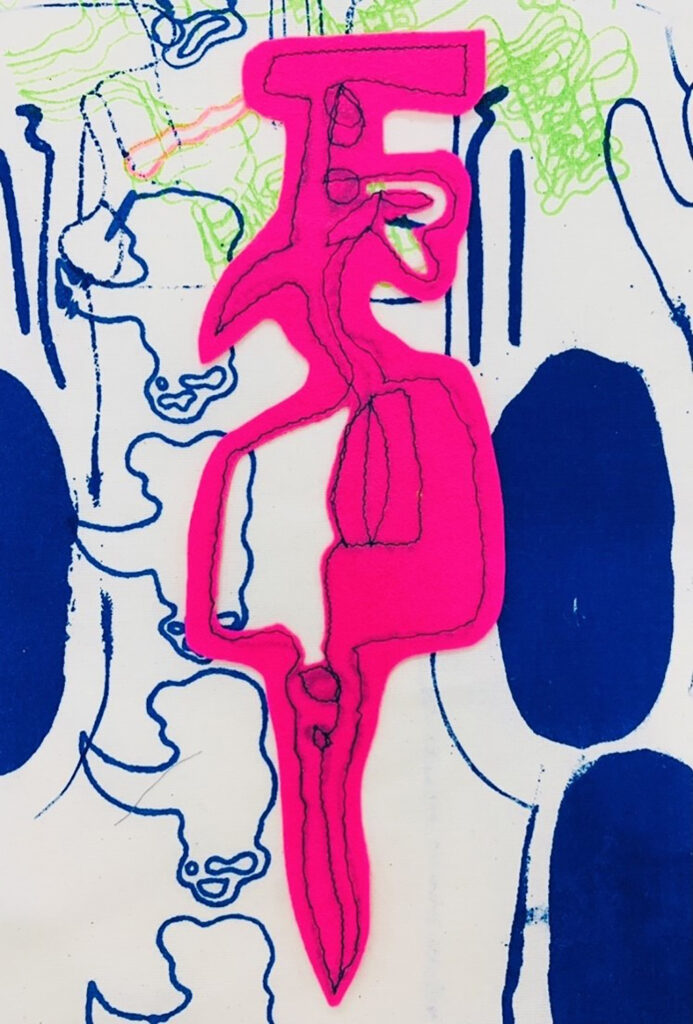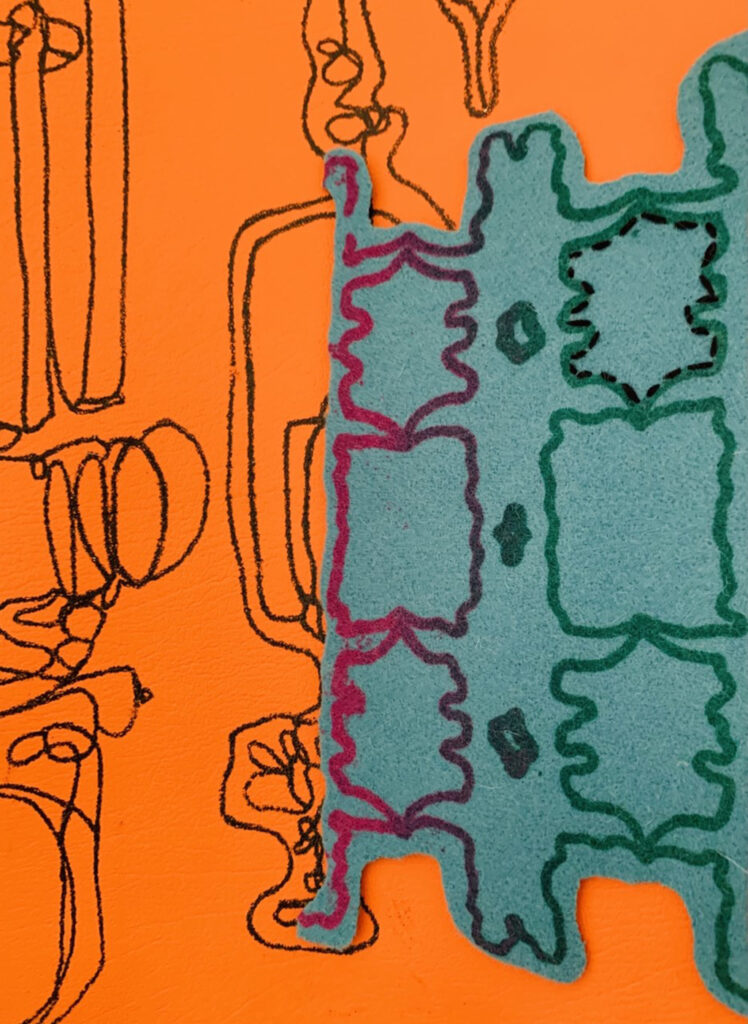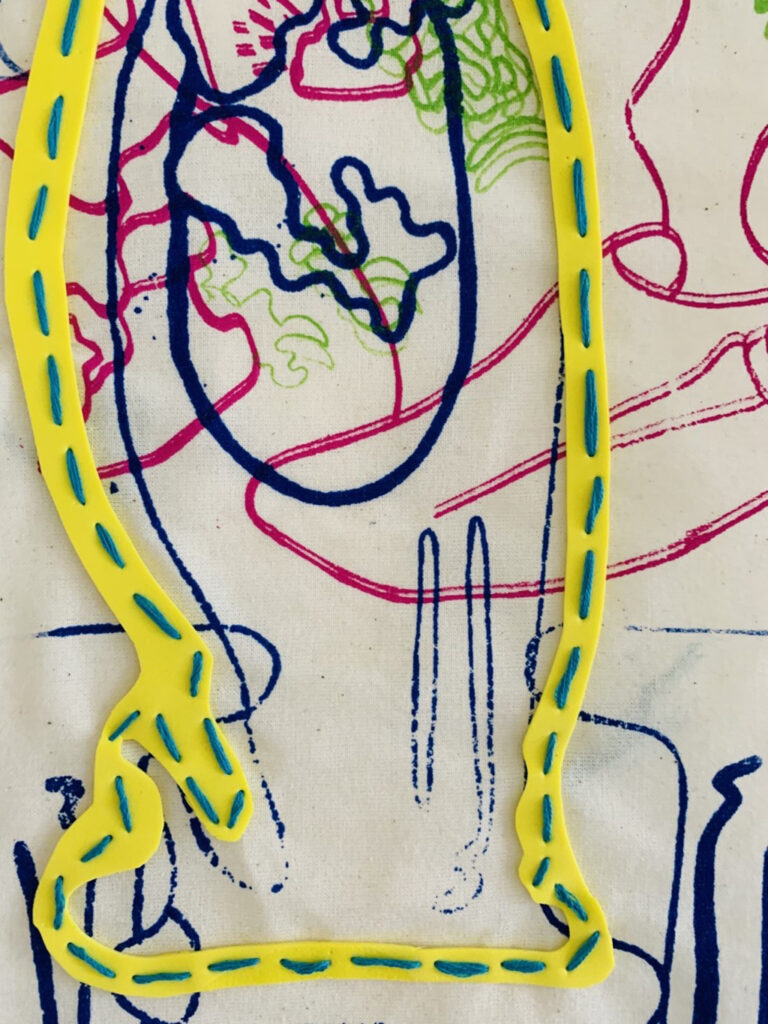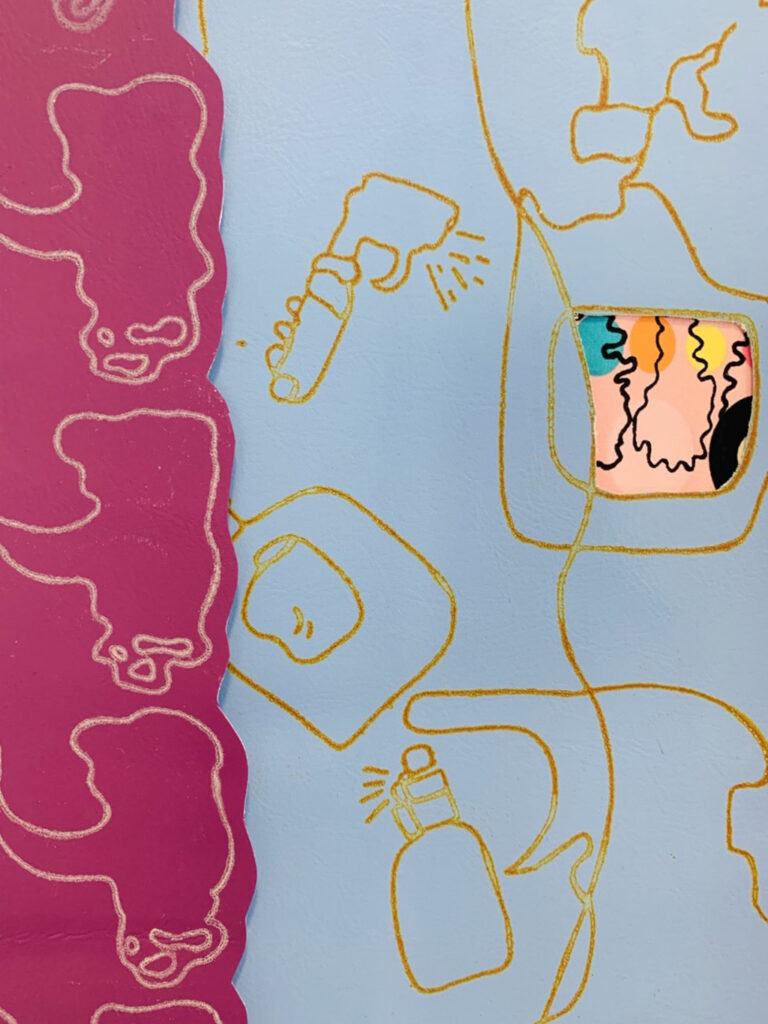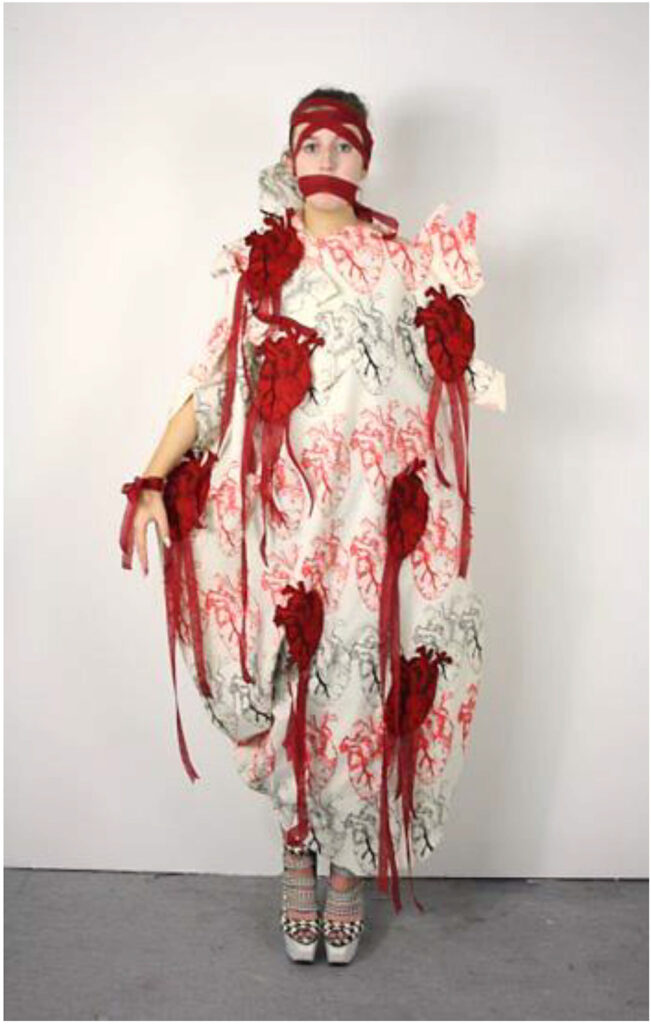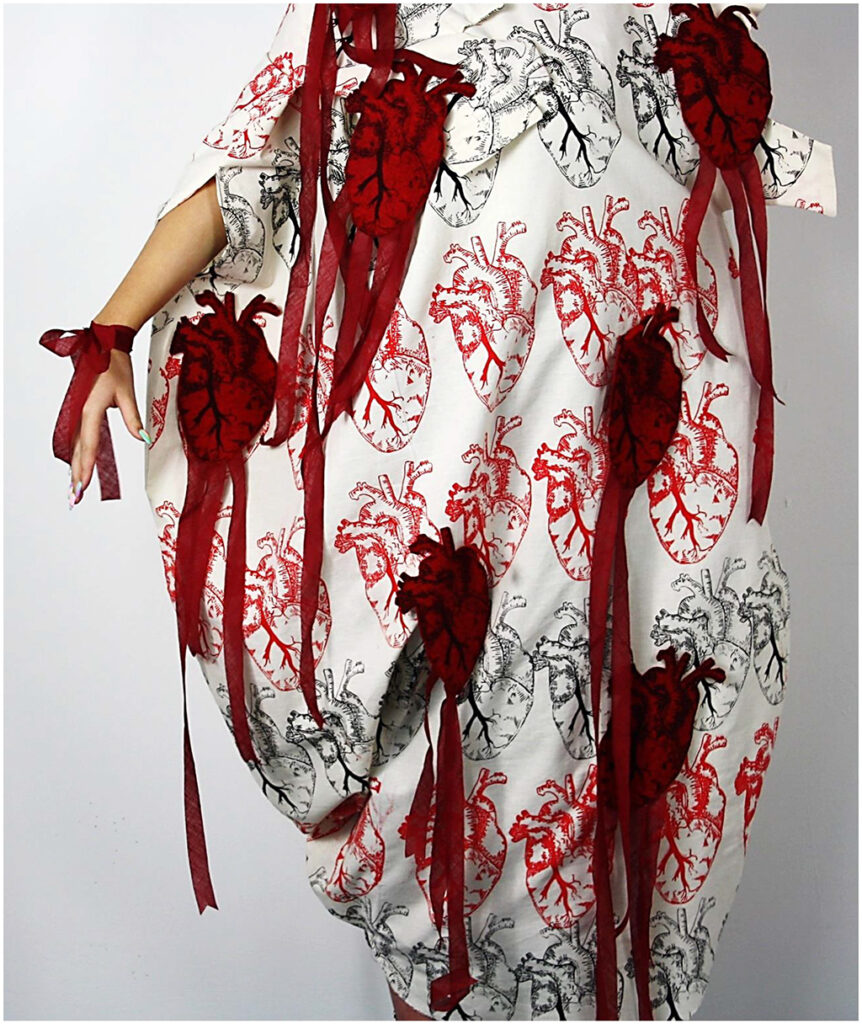
FAD: FASHION AND TEXTILES
Oluwatobi Ajibola
Destination: University/ Employment
The title of this project was ‘Expect the Unexpected’ and develops work produced for my Extended Diploma course. I wanted to create strange beings inspired by the work of Surrealist Max Ernst and contemporary illustrator Linder Sterling. Both make strange compositions collaging together animals, humans and objects to create bizarre and weird imagery. Another artist that I was inspired by was J Semp because his work is bizarre and futuristic looking.
If the national lockdown didn’t happen I could have developed the idea of using peers as models for me to photograph and use in my collages, this didn’t happen so I had to use only magazines.
Back in college I did manage to develop my ideas by transferring tracings of my collages into silk screens. I used a mixture of different brightly coloured fabrics, viylene, existing printed fabrics and PVC. I could have potentially applied more refined details and definition through the sewing techniques, hand and machine stitch and applique but there wasn’t enough time.
The different images, surfaces and colour palettes all helped me convey my idea of ‘Expect the Unexpected’, due to the unusual mix and clash of colour on various surfaces. I have developed my confidence in printing and machine embroidery and want to broaden my skill set at university.
Ellie Bloomfield
Cabin Fever’ was inspired by the uninspired. My FMP began during a Covid-19 lockdown and I was struggling to get motivated due the claustrophobic feeling of being trapped indoors. However, rather than allowing this to negatively affect my project, I decided to embrace these feelings and allow them to direct my work, pushing me to be creative whilst stuck in a small office. Self-reflection realised that to cope with the disorder and unknown of the circumstances, I relied on repetition, order, and control of the space around me.
The Outsider Art heavily influenced my project. I found comparisons between some of the artist’s dispositions and methods, and my own ideas and emotions during the lockdown period. Heinrich Reisenbauer’s organised grid paintings of identical subjects reminded me of my own coping methods, for example, eating the same foods during isolation. His work also emulates the feeling of endlessness, and the repetition of lockdown life, whilst the low-tech materials, remind me of the lack of resources I had at home. In contrast, August Walla’s explosive and expressive murals evokes the feeling of disorder and claustrophobia that I felt at that time, the crushing feeling of cabin fever. The vast distinction between the techniques used by these troubled artists became the basis for my ‘project of two halves’. The work I produced from home was inspired by Reisenbauer’s simple line drawings of subjects around me. However, once I returned to college, I decided to explode my small initial drawings into a large exhibition space, to challenge my creativity and to use my return to the studio space from home to the best of my ability.
My biggest challenge for this project was to trust the process and to allow myself to react as I go without a structured plan for an outcome. I was able to achieve this by having frequent tutor discussions which allowed me to create bite sized plans that provided the control I needed in order to cope and create order within disorder.
This project could have continued forever, and I feel as if the creativity and curiosity I learnt from it will. There are many ways it could have developed, from textiles print to embroidered samples, however I am pleased with where it did conclude as it remains ambiguous and my use of mostly paper-based materials links back to my original resources. In my proposal I had planned to create a ‘range of textiles’ and although my final space and samples do not resemble a traditional example of textiles it holds all of the key elements and explores the idea of a modern take on textiles.
This project not only enhanced my practical skills and creativity but taught me about myself. The purpose of the project was to explore the personal effects of Covid by emulating my emotions through large scale motifs and repetition in an installation environment, but that space itself trapped me and pushed me to work through my struggles and allow the lack of motivation at times to inspire new work
FAD has given me the opportunity to explore a large range of specialities and combine aspects of them all to create my own creative individuality. I have learnt to be more experimental and to not be to be caught up on the outcome and forget to explore the process. I will take these fundamentals on with me into my creative career.
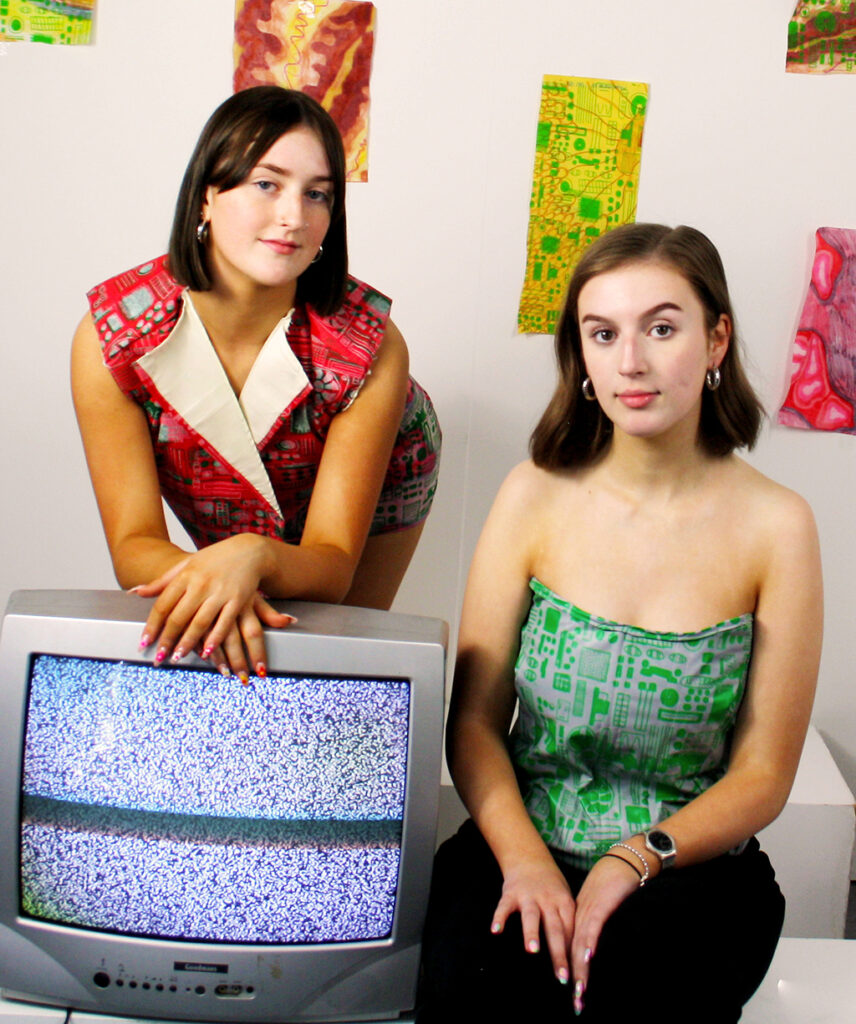
Nathaniel Buffery
Previous Education: King Edward VI College Stourbridge
Destination: BSc Psychology, University of Liverpool
“Space and Fashion” was an investigation both into the historical roots of Space Age but, also a look at more contemporary print techniques and technological innovation. My aim was to create a series of simple 1960s silhouettes with astronomy inspired printed fabrics for a Space-themed garment collection. The idea came from renewed international interest in space travel and personal interest in aesthetics of planetary surfaces and how they may be applied to fashion. I developed my initial ideas in lockdown through research and sketches and then moved onto printing techniques.
My main inspiration for this project were the fashion designers of Space Age such as Pierre Cardin, Paco Rabanne, Andre Courreges etc. Their use of unconventional materials and ‘looking to the future’ in a time scarred by the fear of a world-ending nuclear war was something I could relate to given the limited supplies I had in lockdown and being in a world event where the only outlook to have was to look to the future. Another source of inspiration was Mary Quant and the work of activists in the 1960s who pushed against modesty and prudish culture of the 1950s, allowing for more ‘scandalous’ silhouettes such as the mini skirt and more exposed skin.
Tutor and student comments did influence my ideas a lot. In the early stages, tutor discussions helped me pull all my research into one cohesive idea. Had time not been so tight that I could have developed further ideas such as expanding my collection to look at other 60s silhouettes (e.g., the A-Line or the cape/poncho) or looking at accessories outside of the hypothetical (e.g., shoes or cuffs).
There are many things I have learnt from my FMP project. The main one is improving my practical skills in both textile and fashion design, I specialized in fashion without any prior experience of this field. Although it has been a steep learning curve it has been incredibly useful, not only learning skills for personal use but also how the industry works and how the skills I was using translated onto an industrial scale.
I also learnt more skills in organization and recording my work, that the end-product is not just the finished garment but the journey to get to that work. The most significant thing the FAD has taught me is to go outside my comfort zone, to try new things because it’s better to be rewarded for doing something new rather than doing something mundane that you always do. I would like to apply that to my undergraduate as although it’s a different subject, there are many fields to explore, opportunities to try something new.
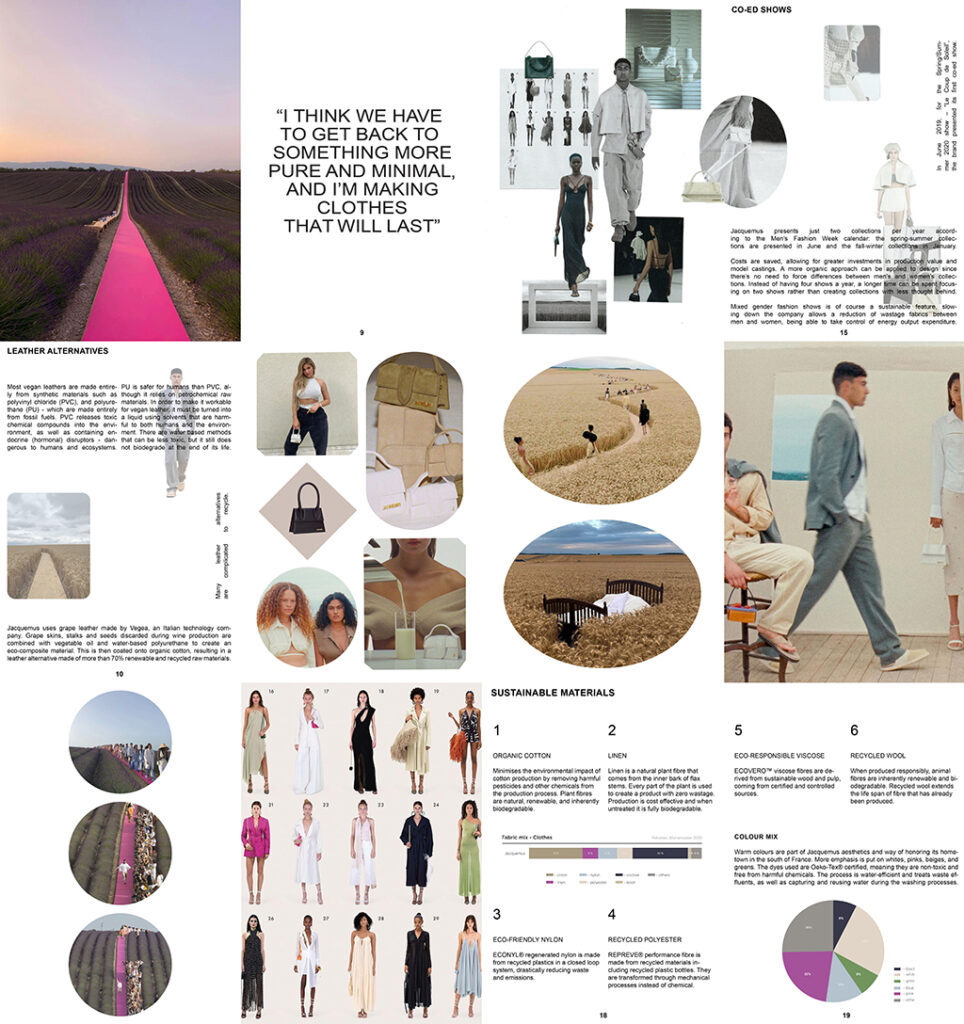
Evie Burgess
Destination: BA Hons Creative Direction for Fashion London College of Fashion UAL
The coronavirus pandemic and how it has affected the fashion industry influenced my initial ideas for this project. I wanted to consider how fashion will change in the future and create work communicating this.
Fashion must become more sustainable, and this is something I wanted to explore in my work. I found an article on Forbes outlining how the fashion industry will be data-driven, sustainable, digital, and simplified in the future. It discusses how new technology and changing customer demands will begin to transform the industry.
My approach in previous projects has always involved photography, an area in which I feel confident, but lockdown meant that opportunities for this were limited. I was able to experiment with hand-rendered techniques such as collage in the initial stages of my project. My experimentation informed the type of practical work I wanted to produce, directing me towards new ideas.
After extensive research into the brand Jacquemus, I created a publication, working in a hypothetical style as if I was producing this for them. Its purpose is to inform potential customers about sustainable practices and methods used in production. I wrote about the brand’s decision to slow down the company through co-ed shows. Doing this allows a reduction of wastage fabrics, being able to take control of energy expenditure. I was able to educate myself on sustainability, which I found was the most rewarding part of my project.
Being on FAD, I have learned that experimentation is a significant process. I feel it allows me to devise ideas that I may not have had if I jumped straight into practical work. I also found I could allow more time to consider the presentation of my outcomes. I wanted to grow my InDesign skills and investigate new techniques that combine text with images. My approach has worked well for this project, and I have the confidence to develop this finesse when I progress to university.

Molly Cartwright
Previous Education: UAL Foundation Diploma in Art & Design, UAL London College of Fashion
Destination: BA (Hons) Fashion Design Technology: Womenswear
My Final Major Project was a reaction to the pandemic I am living in, specifically the effects of the lockdown being anxious, distressed, alienated and frustrated feelings. When stimulating ideas for what my project could be, aware that fashion designers collections are normally a reaction to what is happening in the world around them I decided to look to my own experiences of the current world I’m living in. My initial idea was mainly developed from researching Outsider Art. This work is made by the untrained, and includes work by the mentally ill, child art, work mad by prisoners and those who live in isolation. I wanted to see how being isolated effected their art to inspire how I present my isolated, lockdown feelings through art. Here I discovered motifs of outsider artwork including overlapping, communicating through repetitive words and numbers, and illegibility, which I applied to my initial drawings which then went on to inform garment design.
Outsider artists including Emma Hauck who inspired me to explore my feeling by writing them down in manners that explored the outsider motifs. My drawings reminded me of Gosia Wlodarczak’s work who went on to inspire a significant amount of my practical work, I applied the same fluidity to explore the lack of control felt in lockdown, applied my drawings directly onto silhouettes to see how they would distort the drawing, distortion being something I wanted to achieve to further convey anxiety and alienation and finally experimenting similarly in a performative manner and filming this experimentation to explore another lockdown feeling of mine in a more abstract way, the desire for human touch and connection.
Discussion with tutors and peers was vital for the development of my work, as they suggested interesting artist research and ideas. For example, I had all these ideas of feelings in lockdown and how art has been used as a coping mechanism, thinking about the psychological effects of being confined and even OCD in the pandemic. My tutor’s suggestion of looking into outsider art bound all of my ideas together and led to how I would explore my own time in isolation.
In my proposal my aim was to design a minimum of one garment, however, as ideas developed I realised I did not want my work to result to one garment I wanted my final outcome to be a collection of all my experimentation and fashion films to demonstrate what I was able to achieve in these difficult times.
One of the most significant things I have learnt on FAD is problem solving. Having a lack of resources to work with but, still stimulating alternative ideas, and design development are very valuable skills for both university and industry. FAD has also taught me how to collect my own relevant research from different sources and a range of artists. I think the most successful aspect of my project has been my ability to then stimulate lots of ideas from my research, using my research to inform my practical work and the continuation of this throughout my project.
At university, I want to be able to take my approach to mind mapping, lateral thinking and research and ideas from beyond my specialism and use my planning, resilience and problem-solving skills to work independently and negotiate support from my peers and tutors.
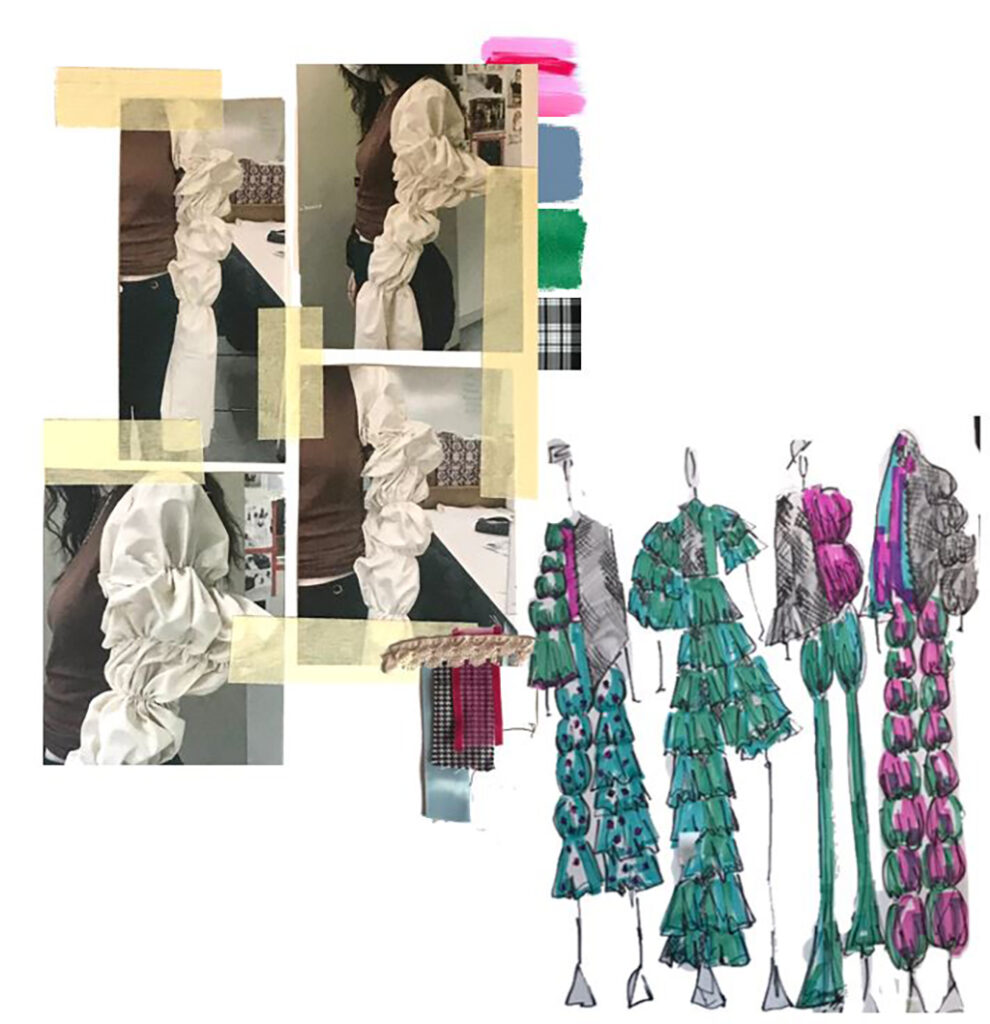
Chloesue Hartill
Destination: Kingston University BA (Hons) Fashion Design
“Fade to Grey” is a project inspired by fascination with the New Romantic Era and how open and how all gender stereotypes were forgotten about. I wanted to look back into the 80s and explore what inspired their flamboyant fashion choices.
Through research I discovered many influences on the New Romantics such as; 19th English Romantic Era, Glam Rock and Sci-Fi. The New Romantic took all of these influences and through clashing and contrasting different styles together created bold, over the top garments.
I created fashion collages to inspire draping and fabric manipulation on the mannequin. I produced a collection of that mismatched and clashed menswear with womenswear and pattern, colour and texture. This project has given me a greater understanding of Fashion throughout the 80s and how it was influenced by many different things which shows fashion is constantly evolving and how the younger generation is constantly looking up to the older generation to inspire their fashion choices.
The foundation course has increased my confidence which can be seen throughout my work as it shows a growing confidence in experimentation and a more varied style than I had at the beginning of the course. I will continue to push my boundaries and to go out of my comfort zone.

Alister Kidger
Previous Education: UAL Foundation Diploma in Art & Design
Destination: Further Education
I think that there is a pressure on people to be perfect and beyond cool from film, TV and social media, especially with celebrities and Instagram models where they are pictured as living the dream and being the centre of everything 24/7, which can make people feel like they need to be more than they already are in a negative way.
For my Final Major Project intend to create a menswear collection titled ‘Unseen’, which is based on the feeling of anxiety in social situations that introverts like myself can feel. The pressure of desperately trying to stand out and be seen as the life of the party, and hiding who you really are for fear that people won’t accept you for as you actually are is a problem for many young people.
I was interested in extremes of constructed personality; the introvert and extrovert and wanted to try and convey those feelings through the fashion design. I was drawn to extroverts like Prince, who was very experimental and wild with his choice of fashion as well as fashion collections like Balmain Fall 2016.
Hiding the body through layering and a dark colour palette informed my early designs. I was also drawn to the idea of censoring the face without it looking like it was done intentionally, and so I was drawn to the idea of covering the face with black cloth which was inspired by the work of Juha Arvid Helminen called The invisible empire.
Due to lockdown, I was unable to construct any garments but feel that this FMP has given me more confidence in fashion illustration and a greater understanding of fabrication.
Sarah Lewis
‘Covid-19’ is a project that portrays the horrific pandemic that hit the world in 2020. Lockdown has had a huge impact affecting everybody’s day to day lives. The experience of being trapped inside and repeating the same routine is what inspired me.
My initial ideas were developed through researching Artists and Designers that were inspired by the pandemic. The influence of Coronavirus can be seen in Fine Art, Fashion. My research extended to investigating how the pandemic was spreading and what the virus looked like. It was a shock to see how beautiful these deadly virus were under a microscope! As a textile designer I was drawn to the patterns and colours in these microscopic images as well as wanting to reference medical equipment.
I am a very hands on designer and enjoy the challenges of developing work practically, so not having access to the textile print resource I instead had time to really experiment and explore drawing in much more depth than I would have done had college been open. This is something significant that I have learnt.
My confidence has grown through being able to communicate my ideas through drawing and in discussing my work with others. Working on my communication skills have certainly prepared me to talk about my work more broadly in future projects at university.
I believe that I managed to achieve all I set out to do. This is through the variety of hangings that could be featured for interiors. Pattern and colour have also been explored massively to create vibrant elements in my designs.
Commitment and resilience to producing my very best work is shown throughout the project and I was dedicated to work hard and focus on developing my ideas, even though at times I found it hard to stay motivated.
Although lockdown has been difficult to cope with, I am so grateful for how it has improved the way I work. I believe that I have pushed myself through working outside of my comfort zone, and I will continue to test my experimentation on my undergraduate course. Overall, it has been a challenging but exciting experience, and it will be the project that I shall always refer to if I am ever struggling in future projects.
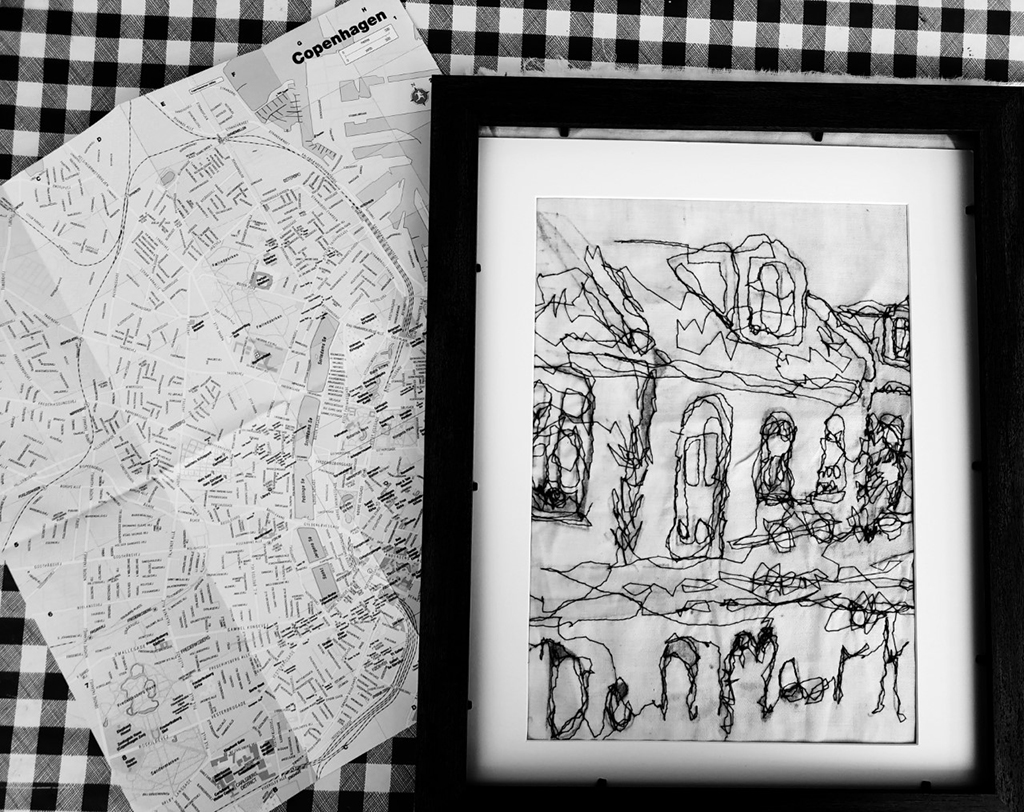
Isabella Loveridge
Previous Education: Kinver High school
Destination: Employment
My work is based on Danish Architecture, I thought the contrast between the old and the new was very stark and different to my own surroundings. I have never visited Denmark but if I ever did, like any tourist, I would want a souvenir to remind me of time spent in a different country. I decided that my textile work would take the form of holiday keepsakes, fabric postcards!
My work has been inspired by a range of textile artists and designers, I particularly drawn to the work of Harriet Popham and Ruth Chalk – these are textile artists who explored architecture using textile techniques and processes. Harriet Popham is an illustrative print designer whose work is complex and very detailed using print and embroidery. Artist working in recycled textile and waste plastic. Chalk is inspired by the urban landscape and works with knit, machine embroidery and collage. I had hope to use some of these techniques but due to the lockdowns and having limited access to textile resources I decided to focus on small scale pieces in techniques I could work on from home. Also working on a small scale meant my work would be more suitable as keepsakes if they were small and easily packed in holiday luggage!
When working from home it was important that I kept in contact with tutor and my peers to help keep me on track and motivated. Whenever I had a one to one or a student gave me advice or feedback on my project, I made notes and reflected on what was discussed. Sometimes I was given ideas or other techniques to try. On one occasion, I had a meeting on Microsoft Teams and a group of us showed a PowerPoint of our work in progress, we talked through our project, and got feedback from each other, ideas of what we could do next, what they liked, what they didn’t like. I found this very supportive and useful.
I have learnt new skills as the work I produced had to be presented digitally. I was initially a bit nervous about using computer but now I use it a lot more. The most useful thing I learnt in my Final Major Project was to be more inventive in using whatever I had around to make work and not worry about having to use traditional materials and techniques. I think this pushed me to think of new ways to work this helped my project develop a lot more than it usually does, as I was forced to try new ways of making work that I would not normally think about. I did a lot more drawing at the beginning so I had lots of work to use to insure my textiles pieces. I planned much better in this project, so I was able make the most of the time when I was in college.
I managed to produce a range of fabric postcards, some figurative, others with text and some that were more abstract to appeal to a wider market. I also made some badges that could be sewn onto clothing.
I think FAD has made me more confident in my work and more confident in myself. I now have a set of skills that I will develop after leaving college, hopefully selling through craft fairs maybe even online!
Ailish McCay
“Anatomy – (between sizes)” is an exploration of the unjust sizing systems in retail clothing stores. I also wanted to challenge what people would consider beautiful by aiming to make something beautiful out of something gruesome. The initial ideas stemmed from personal difficulties of being between two sizes in retail sizing myself and rather than this being strange is actually how most women actual are. I decided that the best way to show this would be to explore the inner working of the body which everyone shares, eluding to the fact that we are all the same no matter the size we wear.
From this research I found certain fashion designers to share the same aesthetic as me, for example Comme des Garçons, Iris Van Herpen etc. Van Herpen’s 2021 London Fashion week display had looks that, to me, looked similar to vein structures, which linked to my idea of using internal organs as a surface decoration. I began to create detailed linear of internal organs and skin structures. I then explored how these organs would look if they were to be used to inform the silhouette of the garment as well as its surface. I explored print and embroidery. I printed heart onto calico and projected a heart shape onto the stretched calico as my pattern for the oversized silhouette.
The idea of the garment being oversized is to hide the natural figure of those who decide to wear it, regardless of what size they are.
As a result of lockdown, starting this project was really difficult for me, my mental health had plummeted and I had absolutely no motivation. It became really important for me to have regular contact with my tutor so I could continue to take small steps to get this project off the ground and not be overwhelmed by what I had to do to complete the project. These talks with my tutor helped me to really grasp where I wanted to go with this project, and what work I could produce until we were able to create something spectacular once reintroduced to the college facilities.
In an ideal world I would have loved to have explored multiple outcomes of this project and create multiple garments, however with the current global status and aforementioned personal problems, this was just not possible. Once reflecting on my initial proposal I feel that I have created a project that has exceeded what I set out for myself. I have proved myself wrong and have proved to myself that I am more than capable in any situation.

Naomi Reynolds
“Beyond the surface” is an exploration of digitally and physically manipulating photographs of natural surfaces such as textured fruit skin, leaves and flowers. From my own photographs I wanted to create abstract patterns and repeat prints, inspired by predicted 2020 and 2021 spring/summer pattern trends. I was interested in the juxtaposition of natural and geometric forms featuring in patterns. There was also a trend that looked at surreal patterns found in nature that were contrasted with a vibrant colour palette creating a new abstract surface. The choice to explore this as my theme was inspired by lockdown partly as I could turn photographs of natural things I could find around the house into patterns moreover, this paired well with working digitally and from home which I think enhanced the work as I could create photographic prints using vibrant and vivid colours which would be hard to achieve in the studio.
I experimented with hand rendered and digitally produced collages, enhancing the colours which juxtaposed the initial image with vibrant and unnatural colours. I was inspired by Sonia Delaunay’s use of geometric shapes and solid primary and secondary colours. I also looked at various photographers of microscopic natural surfaces such as Wojtek Plonka to help me develop my colour palette and designers Margaret Howell and Snow Xue Gao to see the practical applications of the vibrant patterns on garments. The design of the Hermès scarf to help develop my patterns into designs. If I had the opportunity to develop this project further, I think it could be interesting to turn some of my more graphic style patterns into screen prints and experiment with scale, layering, printing and then manipulating, positioning and photographing the printed fabric to see how the patterns distort.
I believe I have achieved all I set out to do in my proposal as I ended up creating a wide range of patterns incorporating the predicted pattern trends and developed those into face mask and silk scarf designs. However, I did not experiment as much with geometric shapes and hand-rendered elements within my work since, working digitally was more successful.
The key things I learnt on Foundation is the importance of time management as well as reviewing your work. Some of my favourite patterns in this project came from revisiting unsuccessful collages or heat transfers, photographing them and digitally manipulating the image. Developing this in my undergraduate course I want to work digitally more and I think this has proved successful.
Sophie Smart
For my FMP project I wanted to design fashion prints exploring the theme of ‘Maps and Journeys’. I want to incorporate telescopes, compasses and their internal mechanical workings. In my last project the range of what I drew inspiration from was narrow and this had an impact on the variety of drawings I produced, this had to be avoided on my FMP.
I have been inspired by textile artist Valerie Goodwin use of intricate lines and shapes which create complex fibre art maps. Closer inspection of her work shows that these patterns are city blocks and landscapes inspired by aerial views of real and imaginary places.
I also referred to The London tube map, ordinance survey maps A-Z as part of my initial research and experimentation.
I also looked into other printed textile designers who have created a simple garments including Susan Stockwell and I have produced a range of printed samples informed by extensive drawing. I explored screen print but also using cogs and wheels to print directly onto my samples. The colour palette I chose was inspired by contemporary trend forecasts. I feel I have developed my subject specific skills in readiness for university.


